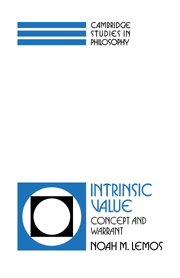Book contents
- Frontmatter
- Contents
- Preface
- Acknowledgments
- Part I Value, plurality, parts, and wholes
- 1 The concept of intrinsic value
- 2 The bearers of intrinsic value
- 3 Organic unities and the principle of universality
- 4 Higher goods and the myth of Tithonus
- 5 Pleasure and its intrinsic value
- 6 Consciousness, knowledge, and the consciousness thesis
- Part II Naturalism, nonnaturalism, and warrant
- Appendix A Chisholm's definition of organic unity
- Appendix B Some naturalistic analyses
- Selected bibliography
- Index
5 - Pleasure and its intrinsic value
Published online by Cambridge University Press: 07 May 2010
- Frontmatter
- Contents
- Preface
- Acknowledgments
- Part I Value, plurality, parts, and wholes
- 1 The concept of intrinsic value
- 2 The bearers of intrinsic value
- 3 Organic unities and the principle of universality
- 4 Higher goods and the myth of Tithonus
- 5 Pleasure and its intrinsic value
- 6 Consciousness, knowledge, and the consciousness thesis
- Part II Naturalism, nonnaturalism, and warrant
- Appendix A Chisholm's definition of organic unity
- Appendix B Some naturalistic analyses
- Selected bibliography
- Index
Summary
What kinds of things are intrinsically good? Traditionally, a variety of things have been thought to be intrinsically good: pleasure, morally good emotions, the satisfaction of desire, correct judgment, knowledge, understanding, consciousness itself, beauty, and, in at least some cases, the flourishing of nonsentient life. In this chapter and the next, I defend the view that most of these things are intrinsically good. In this chapter, however, I focus on the nature and value of pleasure and hedonism in general.
SENSORY AND NONSENSORY PLEASURE
I wish to consider briefly three views on the nature of sensory and nonsensory pleasure. These views are those of Butchvarov, the Chisholm-Brentano view, and a recent proposal by Fred Feldman. Examples of sensory pleasures are gustatory and olfactory pleasures and the pleasures of a warm bath or massage. Examples of nonsensory pleasure are being pleased that one's work is going well, being pleased that one's newborn child is healthy, and being pleased that one's spouse has won the lottery. In earlier chapters, we have used examples of nonsensory pleasures to illustrate the principle of organic unities.
With respect to sensory pleasures, there seems to be no common distinctive sensation or sense content that we can point to as the pleasure. The pleasures of a warm bath, a massage, and a fragrant odor are very different, yet each of these is a sensory pleasure. As different as these pleasures are, they seem to have more in common with one another than they have with nonsensory pleasures.
- Type
- Chapter
- Information
- Intrinsic ValueConcept and Warrant, pp. 67 - 87Publisher: Cambridge University PressPrint publication year: 1994
- 1
- Cited by



